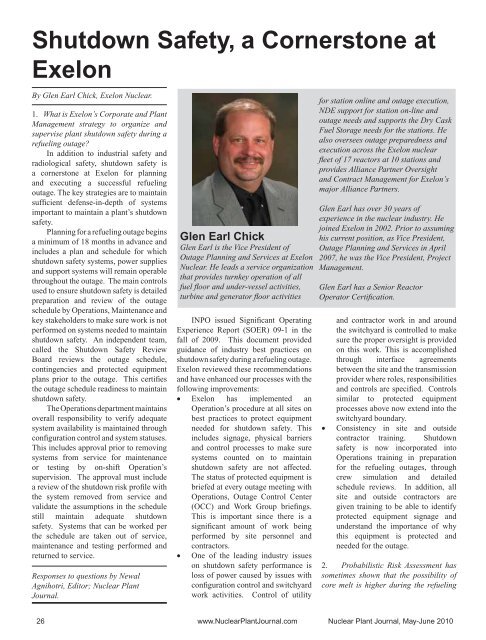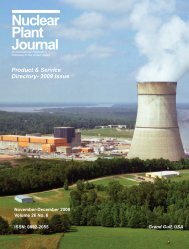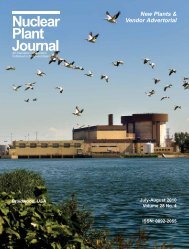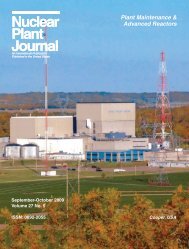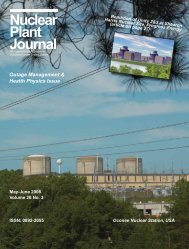New Energy - Digital Versions - Nuclear Plant Journal
New Energy - Digital Versions - Nuclear Plant Journal
New Energy - Digital Versions - Nuclear Plant Journal
Create successful ePaper yourself
Turn your PDF publications into a flip-book with our unique Google optimized e-Paper software.
Shutdown Safety, a Cornerstone at<br />
Exelon<br />
By Glen Earl Chick, Exelon <strong>Nuclear</strong>.<br />
1. What is Exelon’s Corporate and <strong>Plant</strong><br />
Management strategy to organize and<br />
supervise plant shutdown safety during a<br />
refueling outage?<br />
In addition to industrial safety and<br />
radiological safety, shutdown safety is<br />
a cornerstone at Exelon for planning<br />
and executing a successful refueling<br />
outage. The key strategies are to maintain<br />
sufficient defense-in-depth of systems<br />
important to maintain a plant’s shutdown<br />
safety.<br />
Planning for a refueling outage begins<br />
a minimum of 18 months in advance and<br />
includes a plan and schedule for which<br />
shutdown safety systems, power supplies<br />
and support systems will remain operable<br />
throughout the outage. The main controls<br />
used to ensure shutdown safety is detailed<br />
preparation and review of the outage<br />
schedule by Operations, Maintenance and<br />
key stakeholders to make sure work is not<br />
performed on systems needed to maintain<br />
shutdown safety. An independent team,<br />
called the Shutdown Safety Review<br />
Board reviews the outage schedule,<br />
contingencies and protected equipment<br />
plans prior to the outage. This certifies<br />
the outage schedule readiness to maintain<br />
shutdown safety.<br />
The Operations department maintains<br />
overall responsibility to verify adequate<br />
system availability is maintained through<br />
configuration control and system statuses.<br />
This includes approval prior to removing<br />
systems from service for maintenance<br />
or testing by on-shift Operation’s<br />
supervision. The approval must include<br />
a review of the shutdown risk profile with<br />
the system removed from service and<br />
validate the assumptions in the schedule<br />
still maintain adequate shutdown<br />
safety. Systems that can be worked per<br />
the schedule are taken out of service,<br />
maintenance and testing performed and<br />
returned to service.<br />
Responses to questions by <strong>New</strong>al<br />
Agnihotri, Editor; <strong>Nuclear</strong> <strong>Plant</strong><br />
<strong>Journal</strong>.<br />
Glen Earl Chick<br />
Glen Earl is the Vice President of<br />
Outage Planning and Services at Exelon<br />
<strong>Nuclear</strong>. He leads a service organization<br />
that provides turnkey operation of all<br />
fuel fl oor and under-vessel activities,<br />
turbine and generator fl oor activities<br />
INPO issued Significant Operating<br />
Experience Report (SOER) 09-1 in the<br />
fall of 2009. This document provided<br />
guidance of industry best practices on<br />
shutdown safety during a refueling outage.<br />
Exelon reviewed these recommendations<br />
and have enhanced our processes with the<br />
following improvements:<br />
• Exelon has implemented an<br />
Operation’s procedure at all sites on<br />
best practices to protect equipment<br />
needed for shutdown safety. This<br />
includes signage, physical barriers<br />
and control processes to make sure<br />
systems counted on to maintain<br />
shutdown safety are not affected.<br />
The status of protected equipment is<br />
briefed at every outage meeting with<br />
Operations, Outage Control Center<br />
(OCC) and Work Group briefings.<br />
This is important since there is a<br />
significant amount of work being<br />
performed by site personnel and<br />
contractors.<br />
• One of the leading industry issues<br />
on shutdown safety performance is<br />
loss of power caused by issues with<br />
configuration control and switchyard<br />
work activities. Control of utility<br />
for station online and outage execution,<br />
NDE support for station on-line and<br />
outage needs and supports the Dry Cask<br />
Fuel Storage needs for the stations. He<br />
also oversees outage preparedness and<br />
execution across the Exelon nuclear<br />
fl eet of 17 reactors at 10 stations and<br />
provides Alliance Partner Oversight<br />
and Contract Management for Exelon’s<br />
major Alliance Partners.<br />
Glen Earl has over 30 years of<br />
experience in the nuclear industry. He<br />
joined Exelon in 2002. Prior to assuming<br />
his current position, as Vice President,<br />
Outage Planning and Services in April<br />
2007, he was the Vice President, Project<br />
Management.<br />
Glen Earl has a Senior Reactor<br />
Operator Certifi cation.<br />
and contractor work in and around<br />
the switchyard is controlled to make<br />
sure the proper oversight is provided<br />
on this work. This is accomplished<br />
through interface agreements<br />
between the site and the transmission<br />
provider where roles, responsibilities<br />
and controls are specified. Controls<br />
similar to protected equipment<br />
processes above now extend into the<br />
switchyard boundary.<br />
• Consistency in site and outside<br />
contractor training. Shutdown<br />
safety is now incorporated into<br />
Operations training in preparation<br />
for the refueling outages, through<br />
crew simulation and detailed<br />
schedule reviews. In addition, all<br />
site and outside contractors are<br />
given training to be able to identify<br />
protected equipment signage and<br />
understand the importance of why<br />
this equipment is protected and<br />
needed for the outage.<br />
2. Probabilistic Risk Assessment has<br />
sometimes shown that the possibility of<br />
core melt is higher during the refueling<br />
26 www.<strong>Nuclear</strong><strong>Plant</strong><strong>Journal</strong>.com <strong>Nuclear</strong> <strong>Plant</strong> <strong>Journal</strong>, May-June 2010


